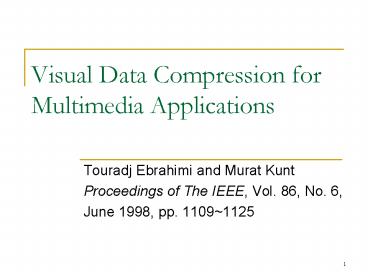Visual Data Compression for Multimedia Applications - PowerPoint PPT Presentation
1 / 34
Title:
Visual Data Compression for Multimedia Applications
Description:
Fractal-Based. 7. Video Coding. Classification. Waveform-Based ... Nature of visual data. Natural, synthetic, text, medical, graphic, etc. Targeted bit rate ... – PowerPoint PPT presentation
Number of Views:63
Avg rating:3.0/5.0
Title: Visual Data Compression for Multimedia Applications
1
Visual Data Compression for Multimedia
Applications
- Touradj Ebrahimi and Murat Kunt
- Proceedings of The IEEE, Vol. 86, No. 6,
- June 1998, pp. 11091125
2
Introduction
- A tutorial on major visual data-compression
techniques. - A list of references for further information on
the details of each method.
3
Outline
- Compression scheme
- Still-Image Coding
- Video Coding
- Pre- And Postprocessing
- Standard
- Dynamic Coding of Visual Information
- Conclusions
4
Outline
- Compression scheme
- Still-Image Coding
- Video Coding
- Pre- And Postprocessing
- Standard
- Dynamic Coding of Visual Information
- Conclusions
5
Compression scheme
- Extracting most relevant features from the origin
data - Assigning bit words to every extracted message
6
Still-Image Coding
- Classification
- Waveform-Based
- A certain model on the statistics of pixels in an
image. - Second-Generation
- Attempt to decompose the data into visual
primitives. - Such as textures and contours
- Fractal-Based
7
Video Coding
- Classification
- Waveform-Based
- Object-Based
- Model-Based
- Fractal-Based
8
Video Coding
- Object-Based
- Three parameter
- Shape
- Textural content
- motion
9
Video Coding
- Object-Based
- Example MPEG 4, H.263 uses this principle with
block based counter parts to increase
interactivity
10
Video Coding
- Model-Based
- Seeking to represent the projected 2-D image of a
3-D scene by a 2-D or 3-D model
11
Video Coding
- Modeling a persons face
- Adjust the 3-D model to the persons face image.
- Texture-map the face image into the wireframe
model.
12
Outline
- Compression scheme
- Still-Image Coding
- Video Coding
- Pre- And Postprocessing
- Standard
- Dynamic Coding of Visual Information
- Conclusions
13
Pre- And Postprocessing
- Enhance the quality and remove the various noise.
- Blocking effect
- Ringing
- Blurring.
- Other application
14
Pre- And Postprocessing
15
Pre- And Postprocessing
Another example
16
Outline
- Compression scheme
- Still-Image Coding
- Video Coding
- Pre- And Postprocessing
- Standard
- Dynamic Coding of Visual Information
- Conclusions
17
Standard
- ISO and CCITT (now the ITU-T)
- For still image
- JPEG, JPEG2000
- For video
- MPEG, MPEG2, MPEG4, MPEG7
- For teleconferencing and video-telephony
- H.261, H.263, H.264
18
Standard
- JPEG
19
Standard
- MPEG-1
- I-frame (Intra frame)
- Coded method is similar to that of JPEG.
- P-frame (Predicted frame)
- B-frame (Bidirectional frame)
20
Standard
- Motion compensation
- Predictive
21
Standard
- Motion compensation
- Bidirectional
- IBBPBBPBBPBBIBBP
22
Standard
- MPEG-1
23
Standard
- MPEG-2
24
Standard
- MPEG-4
- object-base
25
Standard
- MPEG-4
26
Standard
27
Outline
- Compression scheme
- Still-Image Coding
- Video Coding
- Pre- And Postprocessing
- Standard
- Dynamic Coding of Visual Information
- Conclusions
28
Dynamic Coding of Visual Information
- Each application is characterized by
- The type of data to be processd
- Still image, video, stereo image, etc
- Nature of visual data
- Natural, synthetic, text, medical, graphic, etc.
- Targeted bit rate
- Low, medium, high
- Maximum admissible delay
- Ranging from real time to off-line
- The type of communication
- Point-to-point, point-to-multipoint,
multipoint-to-multipoint - A set of functionalities
- Scalability, object manipulation, progressive,
etc.
29
Dynamic Coding of Visual Information
- No universal coding technique exist.
- Example
- Wavelet/subband textures
- Morphological method edges and
contours - Dynamic combination of multiple compression
techniques within the same framework.
30
Dynamic Coding of Visual Information
- A scene description is made up of three
components - Specification of the scene segmentation
- Specification of the representation model
associated to each region (this consists of a
flag that informs the decoder with coding tools
have been selected for a given region) - The coding parameters associated to each region
with respect to the selected representation model.
31
Dynamic Coding of Visual Information
32
Dynamic Coding of Visual Information
33
Outline
- Compression scheme
- Still-Image Coding
- Video Coding
- Pre- And Postprocessing
- Standard
- Dynamic Coding of Visual Information
- Conclusions
34
Conclusions
- The best compression scheme would strongly depend
on the application requirements. - To make the appropriate choice after identifying
the needs of the applications.































